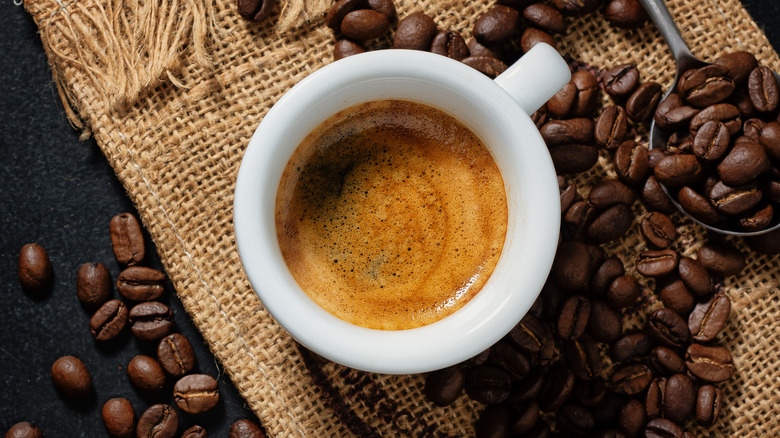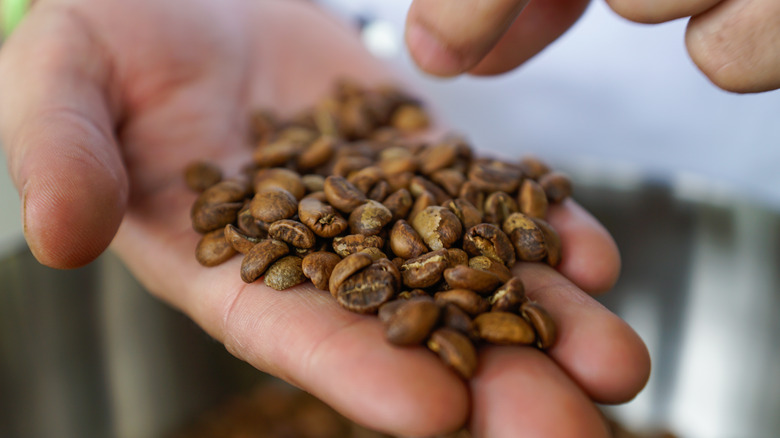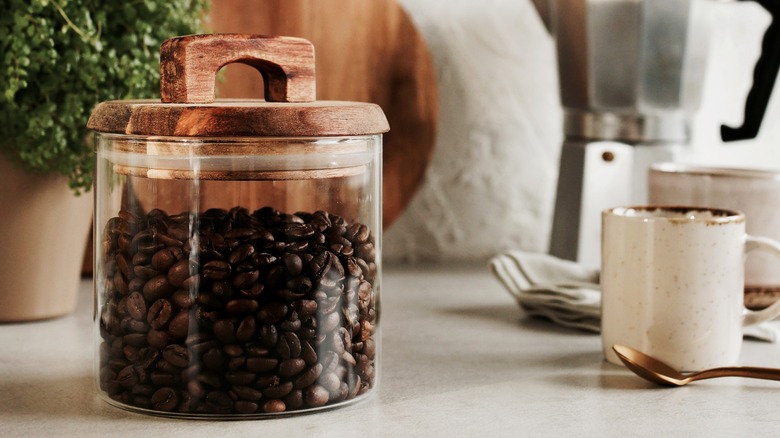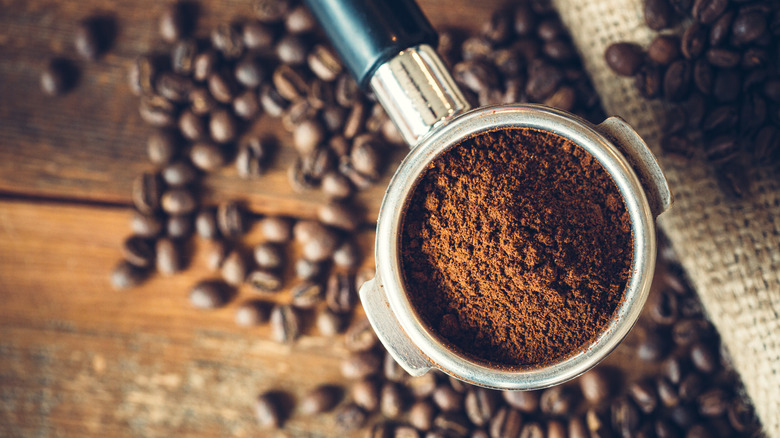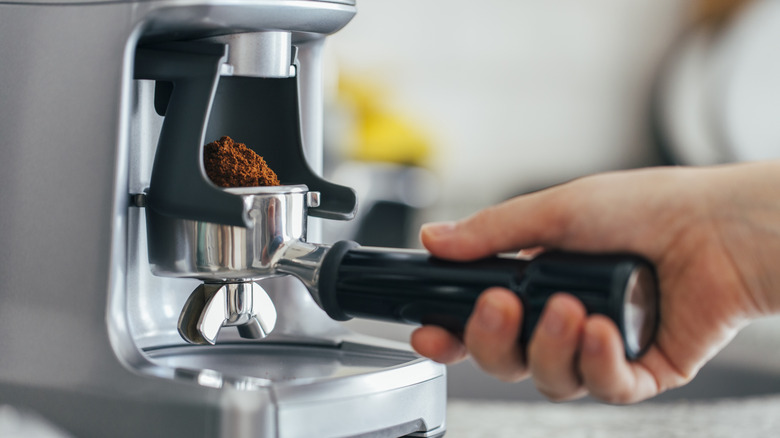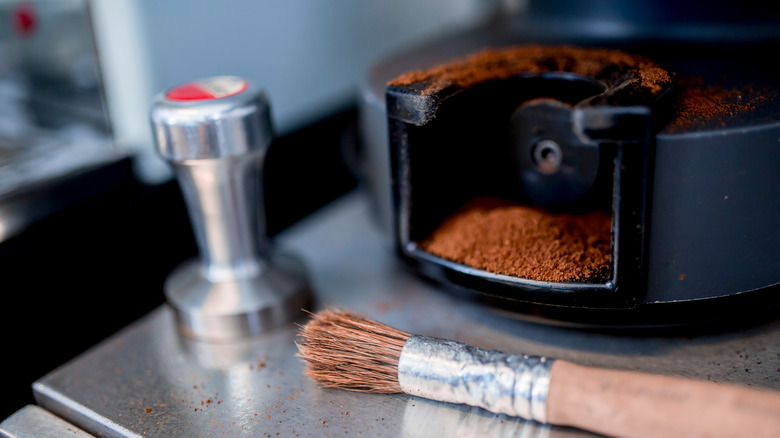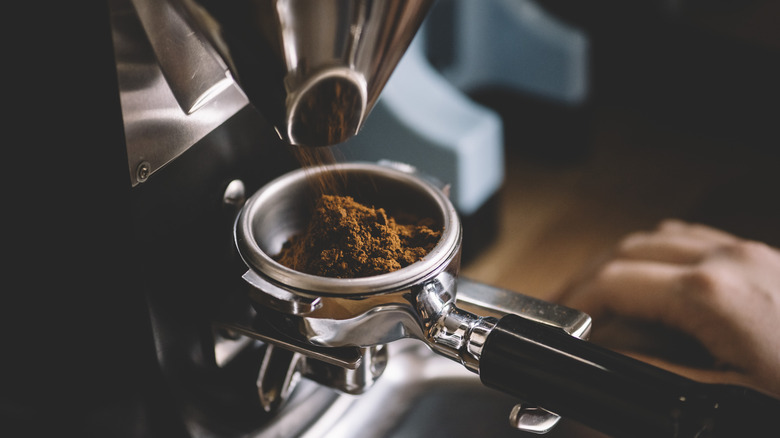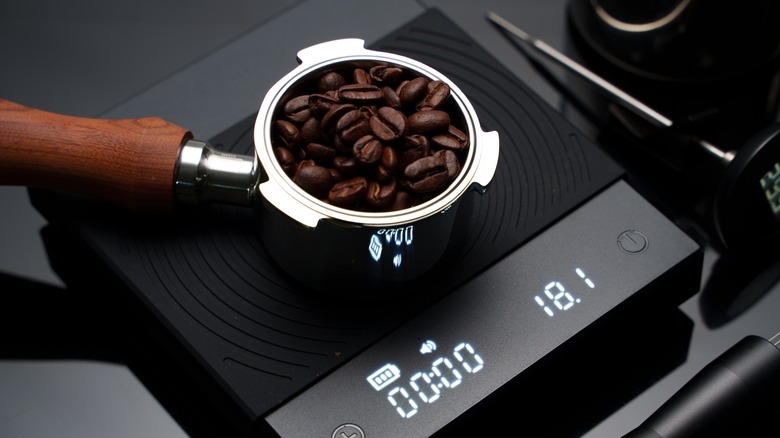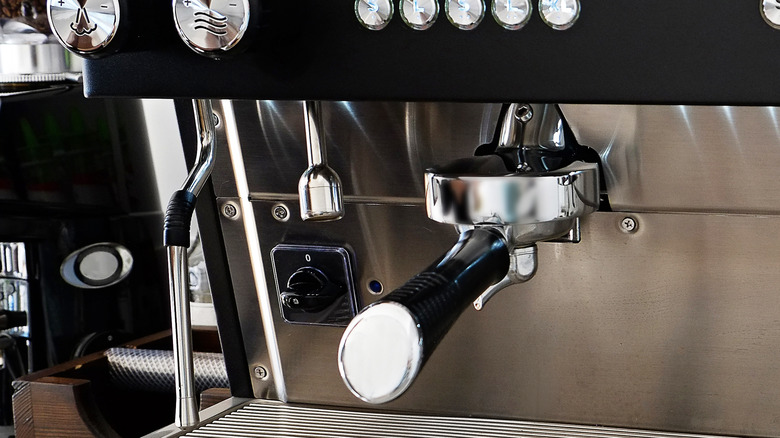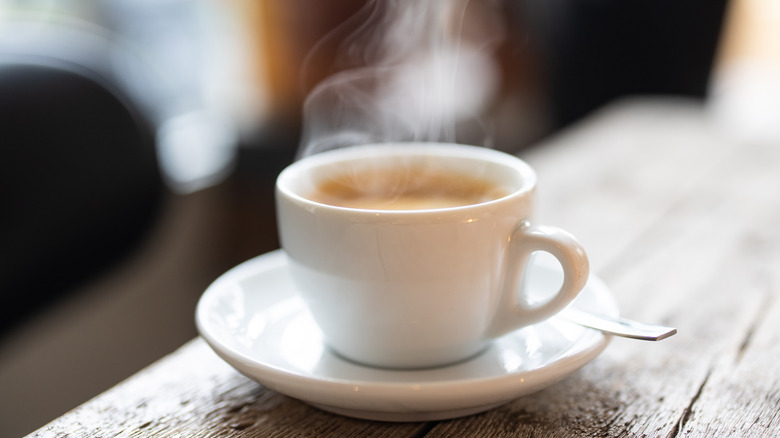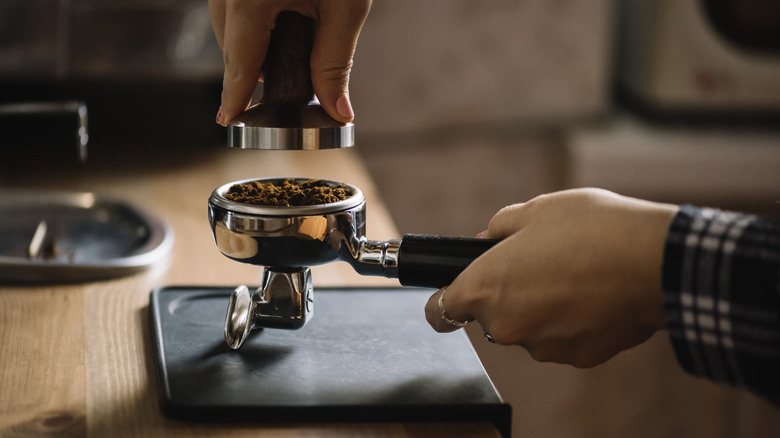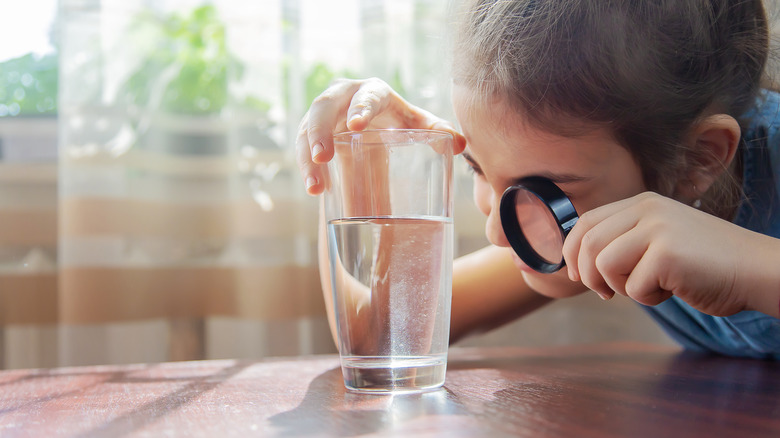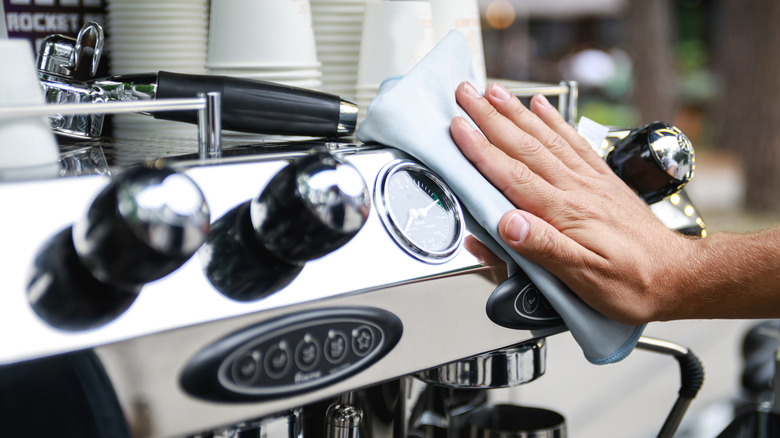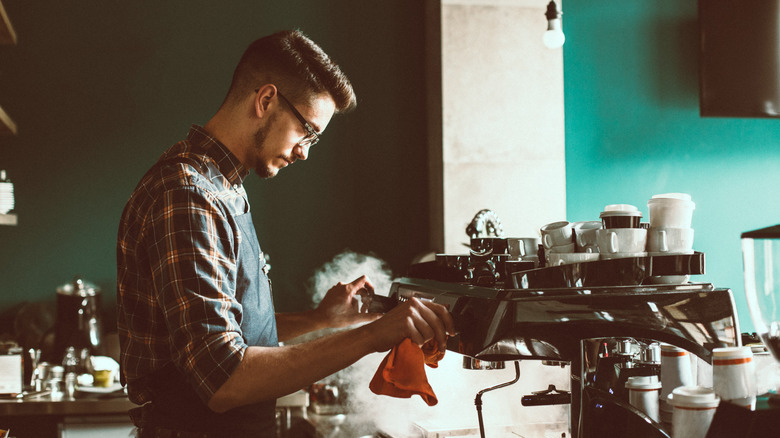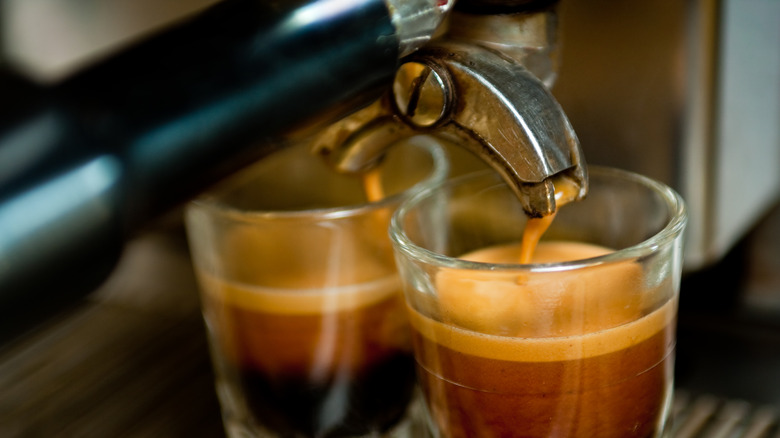Mistakes That Are Leaving You With Less-Than-Perfect Espresso
Espresso makers have increased in quality and dropped in price over the years, which has made it easier than ever to set yourself up for barista-quality coffee in your own home. However, it's simple to get your hands on a shop-quality machine, but getting the perfect espresso shot out of your machine is a lot trickier than it might seem at first.
Making coffee is a chemical process, and like most chemical processes, there are plenty of factors that can have an impact on the final result. Most of these factors are related to the extraction of the coffee by the water that turns through it, while some are down to how well you clean and maintain your brewing equipment. Making stellar coffee is a balancing act that requires, above all, precision at every step, so today we're covering the most common mistakes that might be behind your subpar espresso.
The quality of the coffee is key
If you're hoping to make barista-quality espresso at home, it won't matter how skilled or knowledgeable you are if you skip out on the most fundamental step — choosing good coffee. You wouldn't expect to be able to create a world-class meal out of inferior ingredients, so why should coffee be different?
While the final flavor of your espresso will come down to personal preference, every cup requires a delicate balance of acidity, bitterness, and sweetness, which all starts with the beans. For espresso, it's best to choose coffee that has slightly lower acidity, as you won't have the milk to neutralize that particular characteristic. Light-roast beans tend to be too acidic and not sweet enough for an ideal espresso, but a medium-dark roast should be perfect, giving hints of caramel and chocolate without being as bitter as a fully dark roast.
When in doubt, you can always buy your beans directly from a specialty roaster who'll be able to give you some guidance on what beans to pick and might even have some delicious, rare coffee available that you won't find in a store. You'll also be able to get a good idea of when the beans were roasted, which can also play a part in how your coffee turns out. Remember, beans that are too fresh may still be releasing carbon dioxide and other gasses — a process known as "degassing" — which can impact the brewing process and lead to a less-than-satisfactory espresso.
Coffee beans need to be stored properly
You've probably seen or heard of dozens of ways to store opened coffee beans, including keeping them in a glass jar on the countertop, refrigerating them, freezing them, or even leaving them out in an uncovered bowl. The truth is that if you want to make the perfect espresso, there's only one way to store coffee beans.
Because they're a dried product, it's easy to forget that coffee beans should be treated like fresh produce. If you want to keep your coffee fresh, you should avoid exposing them (as much as possible) to air, moisture, heat, and light. This means the fridge and freezer are both out, as beans stored there will absorb moisture and potentially the aromas of other food you've got stored in there. If you're worried about your coffee going off, there's a simple solution: Buy only as much as you need to last you a week or two.
To keep the beans fresh over that time, you'll need to store them in an airtight container in a consistently cool, dark place with low humidity. While it might be tempting to keep the beans in their original packaging, unless it's got a ziplock feature, it likely won't be airtight enough to keep the coffee fresh, so you'll need to transfer them into a container that provides a firmer seal.
The coffee should be freshly ground
With the topic of freshness still on our minds, it's important to point out that once the beans are ground, they start losing their freshness at a much faster rate than when they were whole. Whether you're buying your beans pre-roasted or doing it at home, the roasting process increases the amount of key aroma and flavor compounds in the coffee, and grinding up the beans means these compounds immediately begin to escape into the air. In fact, it only takes around 45 seconds before you already start losing the aromatic compounds that can make the difference between a good coffee and a perfect one. If these flavors don't make it to the brewing stage, they won't be present in your finished espresso.
Because the coffee has a much greater surface area once it's been ground to a powder, it also starts oxidizing much more quickly while degassing at a higher rate, which can result in a flat, stale-tasting coffee. With all of these processes occurring once the coffee has been ground, it can take just 20 minutes to notice that you've got flat, stale-tasting coffee. You've probably noticed that the best coffee shops grind the beans fresh for every order, and this is why. So, if you really want your espresso to be the best it can be and make sure that your fancy beans don't go to waste, invest in a coffee grinder and grind your coffee as late as possible.
Over or under grinding affects the pour
The other big advantage of grinding your own beans is that you can have complete control over how fine or coarse your ground coffee is, which is important because it all comes back down to the surface area and something we call extraction.
Extraction is simply the name we give to the process of those gorgeous coffee compounds transferring to the water that passes through the grounds, and it plays an enormous part in how our final coffee tastes. The finer the coffee grounds, the more surface area is available for extraction, and the more flavor and aroma you'll end up with in the coffee. With espresso, a finer grind is usually recommended, as we want big flavors that aren't going to be covered up with milk.
However, coffee that's over-extracted will start pulling in too many bitter compounds, resulting in a more bitter espresso. If this is your thing, great, but if your espresso is too astringent, the first step you can take to fix it is to try a coarser grind setting. At the same time, coffee that's under-extracted may end up tasting too salty, sour, or acidic. If it's your first time grinding your own beans, there may be an element of trial and error before you hit the sweet spot.
A dirty grinder makes for an oily espresso
So, you've taken the plunge and treated yourself to a grinder to make the freshest coffee you can, and you've perfected the coarseness of your grind. You're now well on the way to barista-quality espresso, but this uplift won't last long if you don't make sure you clean out the grinder at regular intervals.
The reason for this is that, over time, coffee particles and some of the beans' oily compounds will build up in the grinder and make their way into your next cup. The particles will get stale, and you'll taste this in your coffee. Further, the oil will be noticeable on the surface of your espresso and prevent a nice crema from forming on top.
Fortunately, it's not hard to maintain a clean grinder. For day-to-day cleaning, you can unplug the machine and give it a quick clean with a brush before wiping down the inside of the hopper with a paper towel. Every three to six months, you can give it a deep clean by taking it apart and again, using a soft brush and a paper towel to clean each part. However, you don't want to deep clean your grinder more than is necessary, as it's a tightly-calibrated machine that can experience faults if it's taken apart and reassembled too often.
Using too little coffee makes for a watery espresso
It may sound a little obvious, but it can be tricky to use the right amount of coffee to make a perfect espresso. If you're using a modern grinder, you should be able to set a grind time which, when calculated correctly, will grind the precise amount of coffee needed for an exquisite espresso.
However, some grinders don't have this feature and rely on you manually hitting a switch to start and stop the grinding process. You might even be using an old-school hand grinder, which also requires you to know just how much coffee you need. Additionally, if you're using a double group handle to make two coffees at once, you'll need to remember to use twice as much ground coffee as usual.
You'll be able to tell that you're not using enough coffee if it comes out too watery and lacking in any depth or flavor, and you should also notice that it's not as dark as the espressos you're used to.
A scale is a necessity for perfect espresso
To hit the best level of coffee extraction possible, we need to use what's known as the "golden brew ratio." It's not as complex as it sounds, as it's just about pairing the right amount of coffee with the correct volume of water.
Now, most coffee makers automatically calculate the volume of water required to make an espresso shot, so it's up to you to figure out how much coffee to use. For espresso, we typically want a more concentrated ratio of 1 gram of coffee to 2 grams of water, because we usually add more milk or water to it, depending on the type of drink. However, this is still just a guide, so if you're adding milk to your shot but the coffee flavors aren't coming through enough, you can adjust the ratio to 1:1.5. At the same time, if your shot is too strong for your liking, a 1:3 ratio might work better.
It's great being able to use a precise formula to create perfect coffee, but precise formulas only work if you're using precise measurements, and precise measurements require scales. Fortunately, kitchen scales that measure to a tenth of a gram aren't expensive, so you can easily measure your ground coffee before starting the brewing process. If you're relying on a grinder with a timer, you can experiment with different timings until you find the one that gives you the exact amount of grounds you need.
The group handle shouldn't be cold
Along with having the correct ratio of coffee to water, another key factor in how your espresso will turn out is the temperature at which it's brewed. The brewing process occurs in the group handle — that is, the handle and basket you put your grounds in and attach to the espresso maker. So, if this isn't the right temperature, it will affect the quality of the extraction.
If you start brewing the coffee with a cold group handle, the temperature of the water creating your espresso will drop around 10 degrees. According to Verônica Belchior, a certified Q-grader and coffee researcher speaking to Perfect Daily Grind, "If we use low-temperature water ... we won't extract [the] volatile [compounds] that are interesting for the full perception of coffee."
Fortunately, there's an easy solution to making sure the group handle and portafilter within are at the correct temperature — just leave the handle locked into the coffee maker when it's not in use. The heat of the machine will keep the equipment warm enough for the brewing process while ensuring that it's not so hot that the grounds will burn when they're added.
Make sure your cup is warm enough
Even if your coffee-making equipment is at the ideal temperature for perfect extraction, there's still one more thing that can have an impact on the final drink — the cup. Most coffee cups are made of glass or ceramic, neither of which hold heat particularly well. Like with the group handle, a cold cup will also drop the temperature of your coffee once the liquid hits it. Your coffee will go cold more quickly, and the best aromas and flavors will be less noticeable, creating a much less enjoyable drinking experience.
There are a few ways around this issue. If you're obsessed with coffee and willing to spend a little more on the perfect cup, you can buy a "smart" coffee mug that lets you pick a temperature for it to maintain; however, these are normally too big if you're drinking an espresso. Some coffee makers will have a cup warming rack on the top, using the machine's heat to keep them warm, but there's an even simpler solution. Before you start making your coffee, just fill your cup with hot water to warm it up, then carefully empty it when you're ready to brew.
It's important to tamp down the coffee correctly
Once you've got the perfect amount of ground coffee in your group handle, you need to tamp it down. Tamping is crucial because it compresses the coffee grounds into a uniform puck — the water will always seek out the path of least resistance during extraction, so if the grounds aren't tamped evenly, we can't achieve optimal extraction.
What this means is that if you tamp too hard, the water will struggle to get through the coffee puck. Tamp too lightly and the water pressure required for optimal extraction won't be high enough because the water is passing through too easily. If the tamp is inconsistent, you'll get over-extraction in some areas and under-extraction in others.
For the perfect tamp, add the grounds and give the handle a quick shake to settle them. Set the handle on a flat surface and give it one relatively gentle tamp at a perpendicular angle to lightly create an even puck. Then, give it a harder tamp to give the puck the perfect density. Pull the tamper directly up, and you should be ready to go.
Not any water will do
We've already mentioned how critical it is to use the right amount of water for a shot of espresso, but the temperature and quality of the water are equally as important. You should be set for the former, as the vast majority of espresso machines are designed to keep the water at the right temperature, whether it's plumbed in directly or you add it by hand.
This leaves us with the quality of the water. Now, your first thought might be to use distilled water that's as pure as possible, but interestingly, this isn't the way to go. Firstly, water that's void of minerals has no ions, so it will steal them from the minerals in the metal parts of your coffee maker. As you might guess, this isn't good for your machine's long-term health. Ideally, you should use filtered tap water for your machine, as these filters will remove many of the minerals that might cause limescale buildup while keeping in enough to boost the flavor of your espresso shot.
Using an unclean machine impacts the taste
In the same way that it's important to keep your coffee grinder clean, it's also crucial to keep your coffee maker hygienic. First, it's important to make sure the machine is free of old coffee particles and oils, just like your grinder, to protect the taste of your espresso. However, coffee machines also use water, so without regular cleaning, they can develop mold which, aside from affecting the flavor, can have a negative impact on your health.
Realistically, you should be surface cleaning your machine every day by wiping it down with a clean, damp cloth and using a brush to clean the group handles and the connectors. In terms of deep cleaning and descaling, this really depends on how much you use your coffee machine. If it's a personal coffee maker, you can use cleaning tablets or powder and your machine's cleaning cycle to deep clean and descale the inner workings every two to three months. However, if it's a commercial machine that's making hundreds of coffees a day, it's not uncommon to deep clean this way at the end of every day.
Not purging the group head can ruin your espresso
Purging the group head between shots (running hot water through it after wiping it clean) is important for a number of reasons. What's more, considering it barely takes a couple of seconds, there's no reason not to do it after every coffee.
The first reason for purging the group head and portafilter is that it clears out any old grounds that might be stuck in there after the previous coffee. Anything that's left in the filter will be brewed into the next shot, and depending on how long it's been since you've purged, this could range from an over-extracted flavor that comes from old grounds and oils to potentially hazardous mold.
Purging also means that hot water is running through the group head, which can help it reach the best temperature for extraction. This is especially handy after you've taken the group head off to clean it, as the temperature starts dropping the moment it's detached from the machine. Lastly, it's a good idea to purge the group head if the machine hasn't been used in a while. Depending on the coffee maker, it's possible that water stays inside the piping, which isn't element-heated, so your first coffee could be made with water that's too cold if it hasn't been pulled through.
Not all espresso shots are the same
Now, it's entirely possible that you're not making any of the above mistakes, and for some reason, your espresso still just isn't hitting the spot. The final thing to consider is whether you're actually making the drink you want.
For many, an espresso is merely a single shot of strongly brewed coffee, but this is barely scratching the surface of what an espresso can be. If a single-shot espresso isn't packing enough punch, you can try making a doppio — "double," in Italian — which is effectively just double the amount of espresso.
If you're finding your regular espresso too strong, you could try increasing the amount of water to create a lungo — "long" — shot that takes a longer time to brew and isn't as intense as a standard shot. Lastly, if you're after a smaller, stronger espresso shot, you can try a ristretto. From the Italian word meaning "restrained," a ristretto uses less water than a regular shot meaning the darker and more bitter flavors are left behind, creating a fruitier, sweeter-tasting espresso.

